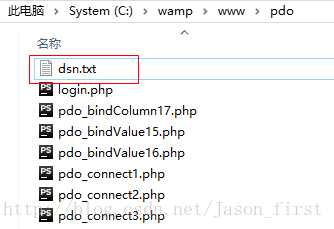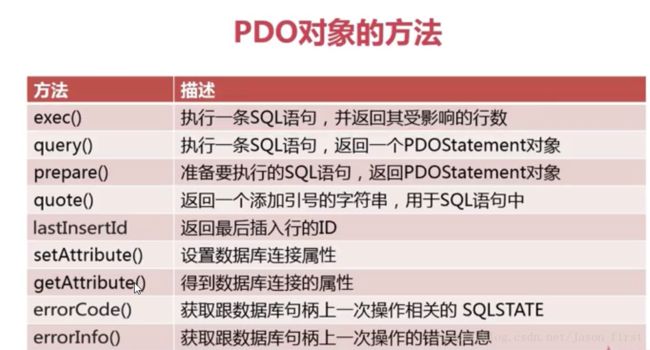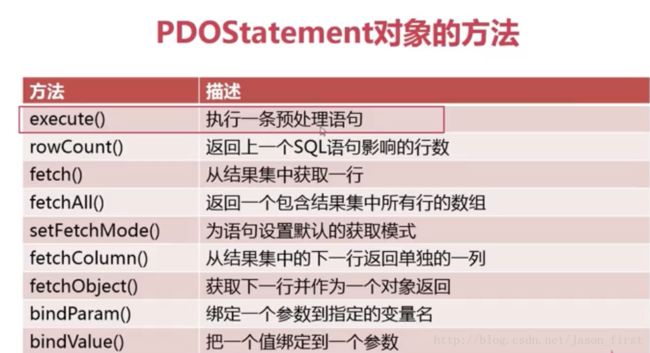PHP学习笔记【二】之《数据库抽象层PDO---PDO连接数据库》
一、PDO连接数据库
1、通过参数形式连接数据库
//通过参数形式连接数据库
try{
$dsn='mysql:host=localhost;dbname=my_db';
$username='root';
$password='';
$pdo=new PDO($dsn, $username, $password);
var_dump($pdo);
}catch(PDOException $e){
echo $e->getMessage();
}
//通过uri的形式连接数据库
try{
$dsn='uri:file://C:\wamp\www\pdo\dsn.txt';
$username='root';
$password='';
$pdo=new PDO($dsn,$username,$password);
var_dump($pdo);
}catch(PDOException $e){
echo $e->getMessage();
}1、exec()方法执行插入记录操作
php
try{
$pdo=new PDO('mysql:host=localhost;dbname=my_db','root','');
//exec():执行一条sql语句并返回其受影响的记录的条数,如果没有受影响的记录,他返回0
//exec对于select没有作用
$sql=<<<EOF
CREATE TABLE IF NOT EXISTS user(
id INT UNSIGNED AUTO_INCREMENT KEY,
username VARCHAR(20) NOT NULL UNIQUE,
password CHAR(32) NOT NULL,
email VARCHAR(30) NOT NULL
);
EOF;
//<<
//比如单引号和双引号,一般用于输出长的html文本或者文本赋值
//这样写sql语句,可以不用对字符型字段两边的单引号进行转义
$res=$pdo->exec($sql);
var_dump($res);
$sql='INSERT user(username,password,email) VALUES("king","'.md5('king').'","[email protected]")';
//echo $sql;
$res=$pdo->exec($sql);
echo $res;
}catch(PDOException $e){
echo $e->getMessage();
} exec()显示其受SQL语句影响的记录的条数。
2、errorCode()和errorInfo()方法查看错误信息
'content-type:text/html;charset=utf-8');
try{
$pdo=new PDO('mysql:host=localhost;dbname=my_db','root','');
$sql='delete from user12 where id=1';
$res=$pdo->exec($sql);
//echo $res.'条记录被影响';
//var_dump($res);
if($res===false){
//$pdo->errorCode():SQLSTATE的值
echo $pdo->errorCode();
echo '
';
//$pdo->errorInfo():返回的错误信息的数组,数组中包含3个单元
//0=>SQLSTATE,1=>CODE,2=>INFO
$errInfo=$pdo->errorInfo();
print_r($errInfo);
}
// echo '
';
// echo $pdo->lastInsertId();
}catch(PDOException $e){
echo $e->getMessage();
}errorCode()返回SQLSTATE的值
errorInfo():返回的错误信息的数组,数组中包含3个单元
//0=>SQLSTATE,1=>CODE,2=>INFO
3、query()方法执行查询语句
header('content-type:text/html;charset=utf-8');
try{
$pdo=new PDO('mysql:host=localhost;dbname=my_db','root','');
//$sql='select * from user where id=2';
$sql='select id,username,email from user';
//$pdo->query($sql),执行SQL语句,返回PDOStatement对象
$stmt=$pdo->query($sql);
var_dump($stmt);
echo '
';
foreach($stmt as $row){
//print_r($row);
echo '编号:'.$row['id'],'
';
echo '用户名:'.$row['password'],'
';
echo '邮箱:'.$row['email'],'
';
echo '
';
}
}catch(PDOException $e){
echo $e->getMessage();
}
header('content-type:text/html;charset=utf-8');
try{
$pdo=new PDO('mysql:host=localhost;dbname=my_db','root','');
$sql='INSERT user(username,password,email) VALUES("king11","'.md5('king11').'","[email protected]")';
$stmt=$pdo->query($sql);
var_dump($stmt);
}catch(PDOException $e){
echo $e->getMessage();
}query(),执行SQL语句,返回PDOStatement对象
4、prepare()和execute()方法执行查询语句
php
header('content-type:text/html;charset=utf-8');
try{
$pdo=new PDO('mysql:host=localhost;dbname=my_db','root','');
$sql='select * from user where username="king11"';
//prepare($sql):准备SQL语句
$stmt=$pdo->prepare($sql);
//execute():执行预处理语句
$res=$stmt->execute();
//var_dump($res);
//fetch():得到结果集中的一条记录
$row=$stmt->fetch();
print_r($row);
//var_dump($stmt);
}catch(PDOException $e){
echo $e->getMessage();
}




